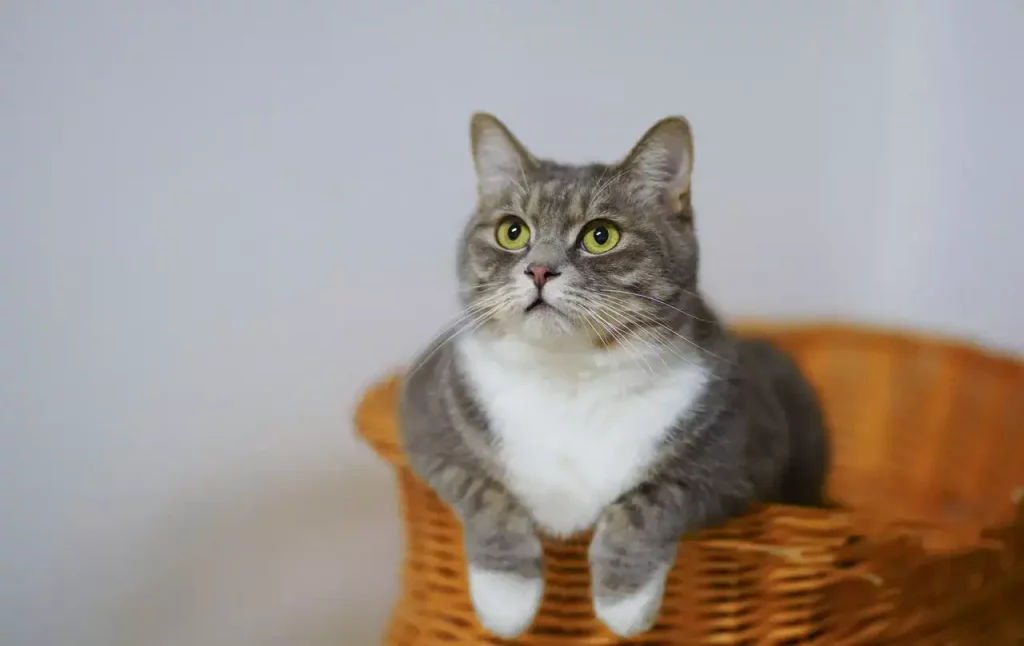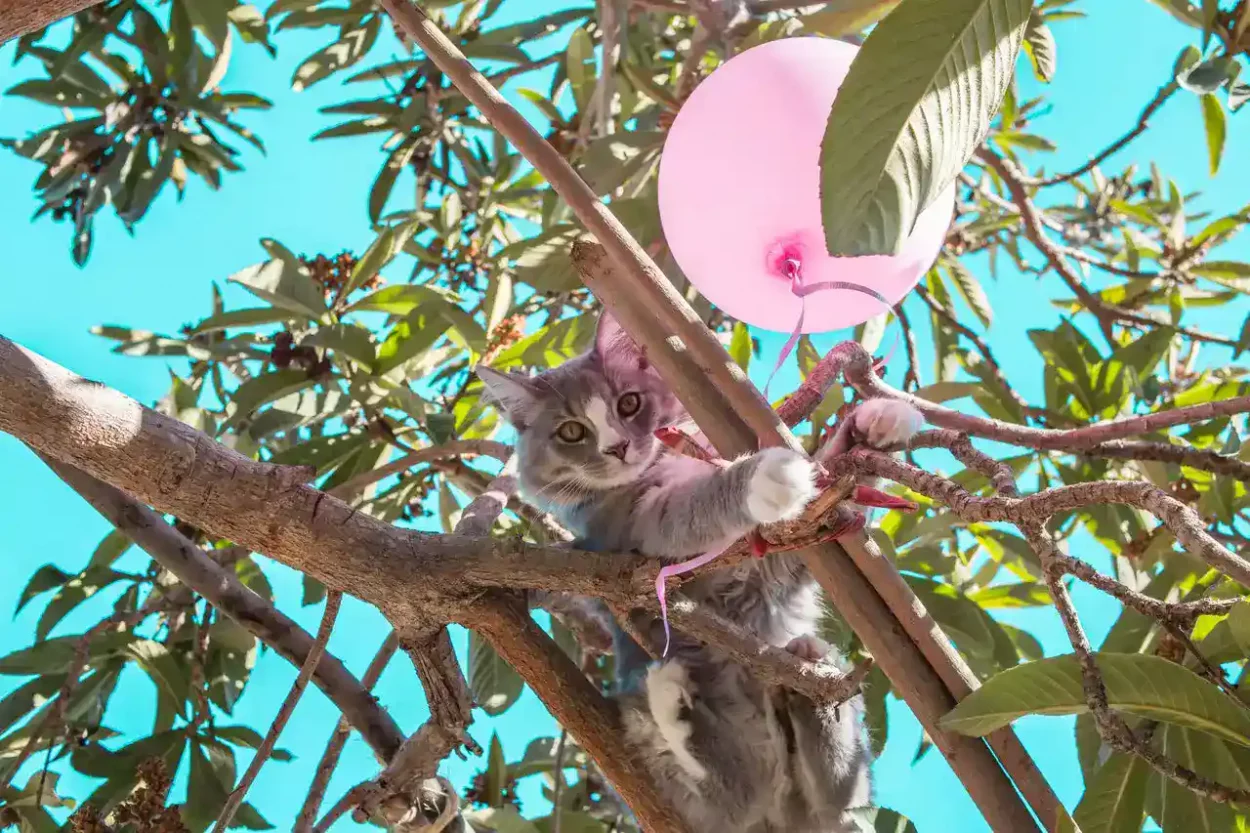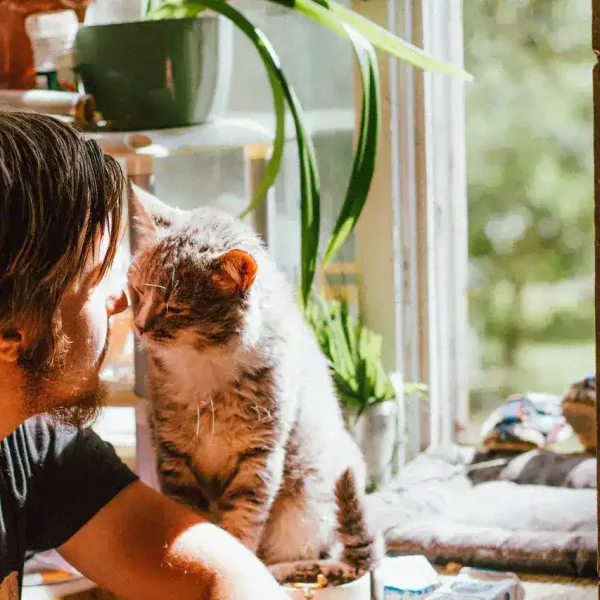When you think of balloons, you tend to conjure up an image of birthday parties, family get-togethers, and celebrations. Based on this, you might wonder why why some cats are scared of balloons, given how much fun and excitement they can bring.
My cat loves balloons. He will chase, catch, and then pop the balloons (which we have to stop, as it’s not that safe). Not all cats like balloons though. For example, my friend’s cat has a real fear and anxiety towards balloons.
I decided to research why this could be. Plus, I even found accounts online where some owners report their cats being scared of hot air balloons too!
Why is my cat scared of balloons? Some cats are scared of balloons due to a previous negative experience, perhaps where one popped loudly in kittenhood. Other cats are afraid of balloons due to the unusual way they sound and feel. In fact, they will hate balloons!
Why is my cat afraid of balloons?
Not all cats are scared of balloons, just some. Like I said already, my cat loves them. But why is it that your cats is afraid of them, and other’s like playing with balloons.
Generally, there are two reasons why balloons can cause a negative response in cats into hating them.
Firstly, some cats will be scared of balloons due a fright caused by the balloon or a situation where there were lots of balloons present. Maybe they thought it was a big ball and dug in their teeth only to be scared silly once the balloon popped.
The second reason can be because of a lack of experiencing new things as a kitten. The window for kittens to learn about the world is pretty small, and after that period, new experiences can be met with worry and anxiety – this will often lead to them peeing themselves when scared.

Are balloons safe for cats?
If your kitten didn’t have the opportunity to see and experience lots of new things as a youngster, they might now react with fear when faced with something they’ve not seen before.
Just imagine how weird a balloon might appear to cats who have anxious personalities. It looks like a ball but doesn’t behave like a ball. It will smell strange and behave oddly when they touch it. It also has a strange texture to it.
To a cat, that could induce anxiety and fear.
And this fear even has a name; globophobia. According to the FearOf.net website, globophobia is defined as the following:
“Globophobia originates from the Greek words globo meaning spherical in terms of balloons and phobos which means deep dread or fear. People suffering from this phobia feel morbid fear at the thought, sight, touch or even smell of balloons. Most individuals, however, are only afraid of the sound made by the popping of balloons.”
Why do cats love balloons?
On the other hand, you might have a cat that likes balloons. Mine does and loves it when we play with them.
He likes to jump up and bite at the balloon, forcing it back up into the air, only to float down again and torment him. This game can go on for ages!
And my cat isn’t alone in loving them. Many of our four-legged friends will love bouncing balloons around and may even enjoy making them pop, so this certainly isn’t a problem that affects all cats .
The reason cats like balloons is the opposite to why some won’t love them; it’s all down to the way balloons behave, feel, and sound during play. Almost like prey, they can then catch and kill a balloon – this is great for cats with this type of personality.
Why some cats are so scared of balloons
We’ve already mentioned that the bang of a popped balloon might be the thing that’s causing the fear, but they could well be other reasons too. Here’s more detail on what induces the fear in some pets.
1. How balloons move
If you think of how a balloon moves around a room, bouncing off the furniture and then flying through the air, there aren’t many other objects that move that way. For some sensitive cats, that weird movement might be enough to make them decide that this is something to keep well away from.
2. How balloons smell
We know that a cat’s sense of smell is so much better than humans, and we’re not just talking about a little bit better. Depending on your cat’s breed, their sense of smell could be up to 100,000 times better than yours is.
Now think about the rubbery smell of a balloon, and then imagine how overpowering that smell might be if you had the smell sensitivity of your cat.
3. How balloons feel
If your cat has been comfortable enough to investigate the balloon, he might then be confused by its texture.
Certainly, if he tries to take it in his mouth, he’s going to find it challenging to get hold to carry, and then, there’s the threat of the bang if he does finally take it in his teeth.
Why are cats scared of hot air balloons?
I mentioned at the start of this how I found something online about cats being scared of hot air balloons. I think this is best left to Dr. Jessica Quimby from Colorado State University, who says:
“It’s a combination of the unfamiliarity with something so large and daunting floating overhead, and the loud, sudden noise of a burner firing up. The latter of these elements is only likely to frighten a cat if you’re standing fairly close – for instance, if you’re attending a balloon festival or watching one launch from your local park. When you think about it, it’s only natural for a cat to be frightened by hot air balloons.”
How to help a cat’s fear of balloons
1. Provide them a safeplace
For some cats, the solution might be that they have a quiet balloon free place to go when celebrations are taking place. That way, your cat can chill in his own space and not be worried about them.
Do make sure that they are well out of hearing distance when you pop the balloons when tidying up.
2. Try counter conditioning techniques
If your cat is a little apprehensive rather than terrified of the balloons, then this might be a good technique to try. Counter conditioning means changing your cat’s emotional response to the balloon from one of being scared to one of being excited.
Here’s a step-by-step guide:
- First off, you need to think about something that your cat loves to eat, eg. a tasty fish sardine!
- Now cut up a heap of these treats into small chunks.
- Take a seat on your sofa and have the balloon on the cushion next to you.
- Show your cat the great treats and then start to feed them one by one.
- Once your cat has had a dozen or so, stand up and move the balloon away out of sight.
- Have a quick break, and then sit down again with the balloon by your side.
- Now repeat again, offering the great treats.
So, you’re now looking for your cat to become excited when he sees the balloon appear because he knows that balloons will equate to great treats coming their way!
3. Desensitization techniques
This is a technique for cat who are quite anxious when near balloons. Desensitization means slowly reducing how sensitive your cat is to being around something which causes him to become anxious, in this case, balloons.
The process aims to gradually introduce the balloon, in the least scary way, to give your cat the chance to get used to them until they are no longer bothered by them.
- Just as with counter conditioning, you need to find a treat which your cat loves to eat.
- Then have a balloon which hasn’t been blown up in one hand and then give your cat a treat with the other hand.
- As long as your cat has shown no signs of being worried, then you can put the smallest amount of air into the balloon and treat again.
- Still nice and calm? Great, yet more treats and a little more air in the balloon.
Over several days you can slowly add more and more air into the balloon until it’s fully blown up, and your cat is still nice and calm.
How to tell if your cat is afraid of a balloon
Sometimes our cat’s body language can be very subtle. So that means that unless you know what you’re looking for, you might miss some of the signs that they’re feeling anxious.
If you spot any of these signs when the balloons come out, then the chances are that your faithful friend is telling you that they’re not happy:
- Tail between the legs: Although this is a sign which we’re probably all familiar with, not all cats hold their tails this way when stressed. Some of our kittens will have their tail straight down and still or with very small movement from side to side when they’re anxious about something. Here’s more about understanding your cat’s tail position.
- Licking of their lips: This is a type of appeasement gesture that your cat might do when trying to tell you that they are feeling worried.
- Ear position: Depending on how your cat’s ears are normally positioned, you might seem them either pinned back to their head or become very upright and rigid.
- Hunched back: When it looks as if your cat is almost trying to disappear into themselves, then they may be finding the situation that they’re in very difficult to cope with. Do be aware, though, that this can be a sign of a range of medical problems and so you should contact your vet if your cat is still hunched up when they’re no longer near the balloons.
- Whale eye: This is when your cat shows more of the white of their eye than usual. This is also sometimes known as half-moon eye.
Should you seek professional help?
If your cat becomes so scared that they cannot be comforted or there is a risk of injury to you or your cat, then you should speak to your vet.
They can rule out any medical conditions that might cause fear type behaviors to appear and recommend a veterinary behaviorist who will help you manage the situation.
Are balloons bad for cats?
In short, yes, balloons are bad for cats. I do not recommend that cats play with balloons unsupervised.
There is the obvious risk where your cat might choke on a balloon once its popped. There’s also a very real concern than the small pieces of chewed balloon can get into your cat’s intestinal tract.
If this happens, there is a risk that the small pieces of balloon could cause a blockage. This will require surgery and could even lead to death if not noticed in time.
Based on that, you should not let your cat play with balloons.
Did You Know? One of the strangest things that cats are scared of are foxes!
Conclusion
For those cats who do find balloons scary, then it can be a real problem when children are keen to have the house adorned with balloons for parties and festive occasions.
Cats who have a more acute sense of hearing may also find the noise of a balloon popping to be more worrying.
If you do have a cat who hates balloons, it might be easier to simply remove any chance of them coming into contact with them, rather than attempting training methods.



Leave a Comment